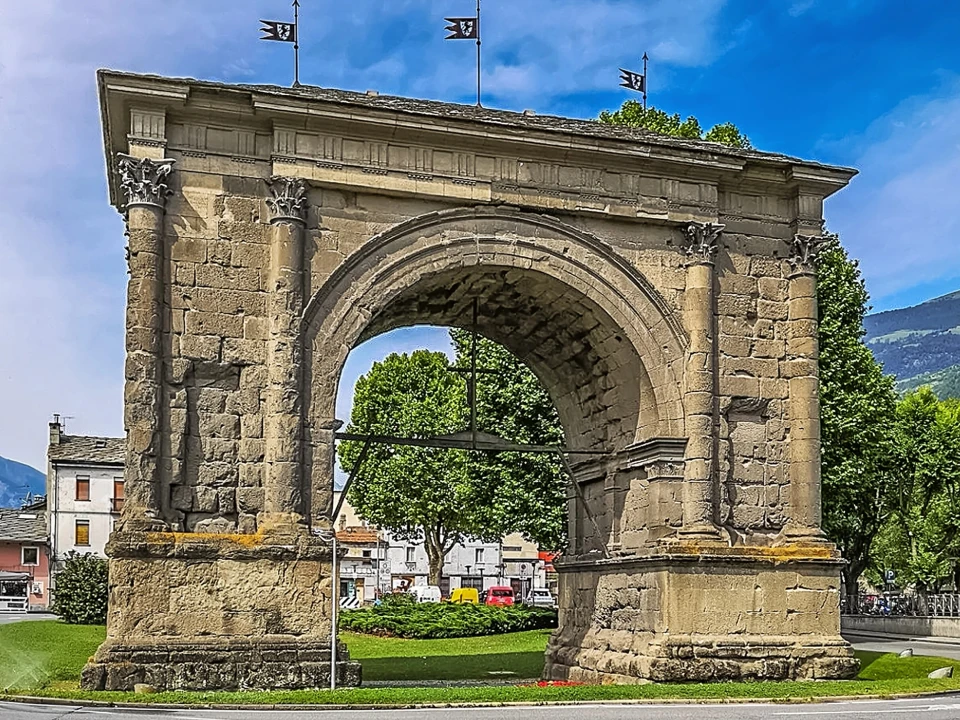Aosta has earned the nickname “little Rome of the Alps” due to the extraordinary wealth of its archaeological sites from Roman times that can be visited like an open-air museum. Conquered by Rome in the days of Augustus, the city was renamed Augusta Praetoria and was enriched with important monuments due to its strategic position on the Roman Via delle Gallie.
It is worth visiting during the day and revisiting again in the evening, when the illuminated Roman remains have an even greater charm.
The Arch of Augustus welcomes you
The first thing you see as you enter the city is the Arch of Augustus. Built between 25 and 23 B.C. to celebrate the Roman victory over the local population, it is one of the starting points for any visit to the historic centre. It stands 11.5 metres high and is made of soft local stone that has deteriorated greatly over the years, so that the reliefs that adorned it are illegible; the arch was partly protected by a slate roof built in 1716 to shelter it from water penetration.
A short walk from the Arch is the Roman bridge, a humpback bridge which spans the old course of the Buthier stream, perfectly preserved and still in use today, which was part of the Roman Via delle Gallie.
Leaving the Arch of Augustus behind, along Via Sant'Anselmo, to access the historical centre you pass through Porta Pretoria, the only Roman gate that has survived undamaged to this day, and which was built in the same period as the Arch. With three openings—a central one for carts, and two side openings for pedestrians—it was composed of two curtain walls separated by a central courtyard that served as a parade ground. On the eastern façade there are still traces of the marble slabs of the original cladding, along with signs of the components that supported the gates that were closed at night. In the Middle Ages, the Porta Pretoria was inhabited by a noble family that took possession of the north side of the tower; today it is home to the tourist information office.
The majestic Roman Theatre
A few steps from Porta Pretoria stands the majestic façade of the Roman Theatre, a masterpiece of Roman provincial architecture of the High Empire, 22 metres high and alleviated by three rows of arches and windows of different sizes. Of the tiers of seats that could seat up to 3 or 4 thousand spectators, only the lower six near the orchestra now remain. What we see of the stage wall, of which only the foundations are left, indicates that it was adorned with columns and statues. A portico connected it to the amphitheatre area, although today only a few arches remain, incorporated into a 13th-century convent.
During the Middle Ages, the theatre was completely neglected and partly used to create other buildings, which were only demolished in the first half of the 20th century thanks to a restoration campaign that allowed it to be returned to the city.
The enigma of the Criptoportico Forense
Opposite the entrance to the Cathedral, in the heart of Aosta's historic centre, is the entrance to one of the Roman underground treasures, the Cripoportico Forense, an imposing covered underground passageway, whose original purpose is still an enigma for archaeologists.
The Cryptoportico is divided into three double corridors with barrel vaults, supported by sturdy travertine arches, and lit by splayed windows that also ensure air flow. Built in the Augustan age, like the Arch of Augustus and the Porta Pretoria, when the whole of Aosta must have been one big construction site, they served the function of retaining and levelling the ground, but are thought to have been used as rooms linked to the imperial cult or as headquarters for religious or civil corporations.
A few more steps through Roman Aosta
This stroll through Roman Aosta can continue along the extensive stretches of still existing walls, to the Porta Decumana necropolis, to the excavations of the Roman villa outside the walls, and to the Aosta Regional Archaeological Museum, which displays a vast section with Roman artefacts related to funerary rites, public and private construction, and personal care.




